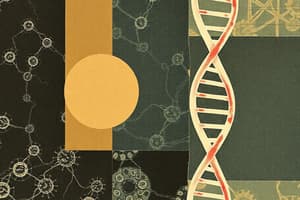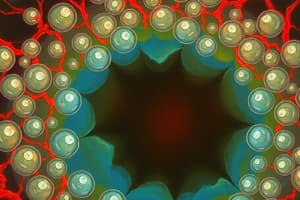Podcast
Questions and Answers
What is the membrane that encloses every cell called?
What is the membrane that encloses every cell called?
Plasma membrane
What is the fluid inside the cell that contains proteins, nutrients, and waste products?
What is the fluid inside the cell that contains proteins, nutrients, and waste products?
Cytoplasm
Where is DNA housed within a cell?
Where is DNA housed within a cell?
Nucleus
What is the primary function of skin cells?
What is the primary function of skin cells?
Which type of cells carry oxygen throughout the body?
Which type of cells carry oxygen throughout the body?
What is the essential organelle that lacks nuclei and functions in oxygen transport?
What is the essential organelle that lacks nuclei and functions in oxygen transport?
What is the process where one parent cell splits into two identical daughter cells?
What is the process where one parent cell splits into two identical daughter cells?
What type of cells undergo reduction division to create four unique gametes?
What type of cells undergo reduction division to create four unique gametes?
What is the main function of the Golgi Apparatus in a cell?
What is the main function of the Golgi Apparatus in a cell?
Which cell organelle is responsible for generating ATP and helping maintain cellular metabolic balance?
Which cell organelle is responsible for generating ATP and helping maintain cellular metabolic balance?
In which cellular structure is DNA contained, facilitating transcription and translation?
In which cellular structure is DNA contained, facilitating transcription and translation?
What is the main function of plastids in plant cells?
What is the main function of plastids in plant cells?
Flashcards are hidden until you start studying
Study Notes
Exploring Cells: Structures, Types, Division, Functions, Organelles
Cells are the fundamental units of life. They come in diverse forms yet share core characteristics across all living beings, from single-celled microorganisms like bacteria to complex multicellular organisms such as humans. In this exploration, we'll delve into the world of cells, examining their structures, types, mechanisms behind division, critical roles they play in our bodies, and essential cell components known as organelles.
Cell Structure
At its most basic level, every cell is enclosed within a membrane, called the plasma membrane, which separates it from its environment while regulating what enters and exits the cell. Inside this membrane lies the cytoplasm, a fluid filled with proteins, nutrients, waste products, and other molecules. Nuclei also lie within the cytoplasm—these contain DNA, genetic information instructions crucial for growth, reproduction, and maintaining overall function.
Different Cell Types
Despite sharing common features, various cell types fulfill distinct tasks. Some examples include:
- Skin cells: These form an outer barrier protecting against bacteria, moisture loss, and ultraviolet light damage. Skin cells continually slough off and self-renew, replaced by new skin cells generated below the surface.
- Red blood cells: Devoid of nuclei and other cell organelles, these cells carry oxygen throughout our body via hemoglobin.
- Muscle cells: Responsible for contraction and movement, muscle cells can either be fibrous skeletal muscles working through voluntary control, smooth muscles that contribute to involuntary movements in organs such as the stomach wall, or cardiac muscle cells responsible for pumping blood within the heart.
Cell Divison
Before exploring how cells divide, consider two key terms: mitosis and meiosis. During mitosis, one parent cell splits into two identical daughter cells; this process occurs during growth, repair, and normal functioning of an organism. Conversely, during meiosis, diploid cells undergo reduction division to create four unique gametes, each containing half the number of chromosomes found in the original cell. This process leads to sexual reproduction and variation among species.
Cell Functions
In addition to performing specific duties characteristic of individual cell types, cells work together cooperatively through several interconnected processes:
- Metabolism: Breaking down food molecules and producing energy in the form of ATP (adenosine triphosphate).
- Transport: Shuttling materials back and forth between intracellular compartments and extracellular environments.
- Communication: Utilizing signaling pathways to coordinate activities between cells.
Cell Organelles
Certain vital structures, referred to as organelles, reside within each cell and perform specialized jobs. Notable examples include:
- Endoplasmic Reticulum: Producing lipids and proteins destined for transport outside the cell.
- Golgi Apparatus: Modifying and packaging these newly synthesized molecules before dispatching them out of the cell.
- Lysosome: Breaking down worn-out cell parts, foreign particles, and waste material.
- Mitochondria: Generating ATP and helping maintain cellular metabolic balance.
- Nucleus: Containing DNA and facilitating transcription and translation.
- Plastid: Found mainly in plants and photosynthetic algae, plastids convert sunlight into chemical energy stored in glucose molecules.
These organelles enable cells to execute numerous tasks simultaneously, making our bodies capable of carrying out everyday functions and fostering complex systems that sustain life. Understanding cell biology provides insights into disease processes, development, evolution, and innovative medical applications.
Studying That Suits You
Use AI to generate personalized quizzes and flashcards to suit your learning preferences.




